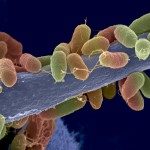Link to Pubmed [PMID] – 8660464
Curr. Genet. 1996 Jul;30(2):174-80
A worldwide collection, of 76 F. oxysporum f.sp. elaeidis isolates (Foe), and of 21 F. oxysporum isolates from the soil of several palm grove was analysed by RFLP. As a probe, we used a random DNA fragment (probe 46) from a genomic library of a Foe isolate. This probe contains two different types of sequence, one being repeated and dispersed in the genome “Palm”, the other being a single-copy sequence. All F. oxysporum isolates from the palm-grove soils were non-pathogenic to oil palm. They all had a simple restriction pattern with one band homologous to the single-copy sequence of probe 46. All Foe isolates were pathogenic to oil palm and they all had complex patterns due to hybridization with “Palm”. This repetitive sequence reveals that Foe isolates are distinct from the other F. oxysporum palm-grove soils isolates. The sequence can reliably discriminate pathogenic from non-pathogenic oil palm isolates. Based on DNA fingerprint similarities, Foe populations were divided into ten groups consisting of isolates with the same geographic origin. Isolates from Brazil and Ecuador were an exception to that rule as they had the same restriction pattern as a few isolates from the Ivory Coast, suggesting they may originated from Africa.

